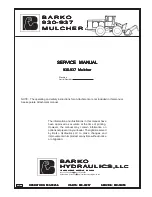
Safety
3
•
Never jerk the control levers; use a steady
motion.
•
Keep your hands, feet, hair, and loose clothing
away from any moving parts.
•
Operate only in daylight or good artificial light.
•
Do not operate the traction unit while under the
influence of alcohol or drugs.
•
Watch for traffic when operating near or crossing
roadways.
•
Use extra care when loading or unloading the
traction unit onto a trailer or truck.
•
Do not touch parts which may be hot from
operation. Allow them to cool before attempting
to maintain, adjust, or service.
•
Check for overhead clearances (i.e. branches,
doorways, electrical wires) before driving under
any objects and do not contact them.
•
Before digging, have the area marked for
underground utilities, and do not dig in marked
areas.
•
Locate the pinch point areas marked on the
traction unit and attachments and keep hands and
feet away from these areas.
Slope Operation
Slopes are a major factor related to loss-of-control
and tip-over accidents, which can result in severe
injury or death. All slopes require extra caution.
•
Do not operate the traction unit on hillsides or
slopes exceeding the angles recommended in the
Stability Data section, page 10, and those in the
attachment operator’s manual. See also the
slope chart on page 5.
•
Operate up and down slopes with the heavy
end of the traction unit uphill. Weight
distribution changes. An empty bucket will make
the rear of the traction unit the heavy end, and a
full bucket will make the front of the traction
unit the heavy end. Most other attachments will
make the front of traction unit the heavy end.
•
Raising the loader arms on a slope will affect the
stability of the machine. Whenever possible,
keep the loader arms in the lowered position
when on slopes.
•
Removing an attachment on a slope will make
the rear of the traction unit heavy. Refer to the
Stability Data section, page 10, to determine
whether the attachment can be safely removed
on the slope.
•
Remove obstacles such as rocks, tree limbs, etc.
from the work area. Watch for holes, ruts, or
bumps, as uneven terrain could overturn the
traction unit. Tall grass can hide obstacles.
•
Use only Toro-approved attachments.
Attachments can change the stability and the
operating characteristics of the traction unit.
Warranty may be voided if used with
unapproved attachments.
•
Keep all movements on slopes slow and gradual.
Do not make sudden changes in speed or
direction.
•
Avoid starting or stopping on a slope. If the
tracks lose traction, proceed slowly, straight
down the slope.
•
Avoid turning on slopes. If you must turn, turn
slowly and keep the heavy end of the traction
unit uphill.
•
Do not operate near drop-offs, ditches, or
embankments. The traction unit could suddenly
turn over if a track goes over the edge of a cliff
or ditch, or if an edge caves in.
•
Do not operate on wet grass. Reduced traction
could cause sliding.
•
Do not park the traction unit on a hillside or
slope without lowering the attachment to the
ground and setting the parking brake.
Содержание Dingo TX 22306
Страница 7: ...Safety 5 Slope Chart...






































